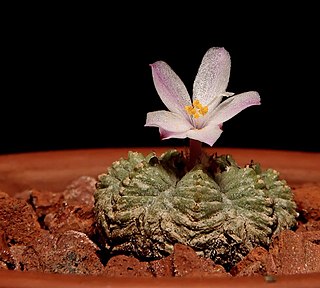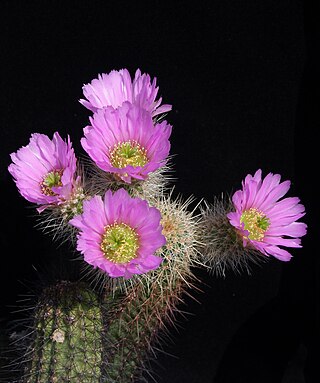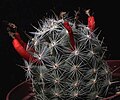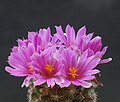
Cochemiea is a genus of cactus. It has previously been synonymized with Mammillaria, but molecular phylogenetic studies have shown that when broadly circumscribed, Mammillaria is not monophyletic, and Cochemiea has been accepted as a separate genus.

Cochemiea macdougallii is a species of cactus in the genus Cochemiea.

Mammillaria dioica, also called the strawberry cactus, California fishhook cactus, strawberry pincushion or fishhook cactus, is a cactus species of the genus Mammillaria. Its common name in Spanish is biznaga llavina.

Turbinicarpus pseudopectinatus is a species of plant in the family Cactaceae.

Aztekium ritteri is a species of cactus native to the Mexican state of Nuevo León.

Echinocereus fendleri is a species of cactus known by the common names pinkflower hedgehog cactus and Fendler's hedgehog cactus. It is named in honor of Augustus Fendler.

Echinocereus viridiflorus is a species of cactus known by the common names nylon hedgehog cactus, green pitaya, and small-flowered hedgehog cactus. It is native to the central and south-central United States and northern Mexico, where it can be found in varied habitat types, including desert scrub, woodlands, dry grasslands, and short-grass prairie.

Echinocereus pentalophus, with the common name ladyfinger cactus, is a species of Echinocereus cactus, in the tribe Echinocereeae Tribe. It is native to North America.

Echinocereus berlandieri is a species of hedgehog cactus. Its range includes most of South Texas, and is commonly found along the Nueces River and the lower Rio Grande.

Mammillaria sheldonii is a species of cactus in the subfamily Cactoideae.

Echinocereus fasciculatus, commonly known as pinkflower hedgehog cactus, is a clumping cactus (Cactaceae) with brilliant magenta flowers and long spines found in the Sonoran Desert.

Echinocereus coccineus is a species of hedgehog cactus. Its native to Northern and Central America. It grows on full sun, in sandy or rocky well-drained soil. It can survive in hardiness zones 8–11.

Echinocereus nivosus is a species of cactus native to Mexico.

Pelecyphora macromeris, the nipple beehive cactus, is a species of cactus in the United States and Mexico. In the Chihuhuan Desert, it is common and has a wide range.

Aztekium hintonii, is a species of cactus in the genus Aztekium. It is the second species of Aztekium discovered by George Sebastián Hinton in 1991.

Echinocereus scheeri is a species of hedgehog cactus in the family Cactaceae, native to northern Mexico. With its dramatic offsets, it has gained the Royal Horticultural Society's Award of Garden Merit.

Echinocereus enneacanthus is a species of flowering plant first described by George Engelmann.

Pelecyphora dasyacantha is a species of flowering plant in the family Cactaceae, native to the Mexico.

Echinocereus cinerascens is a species of cactus native from Texas to Mexico.

Echinocereus spinigemmatus is a species of cactus native to Mexico.























